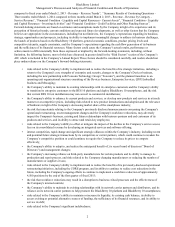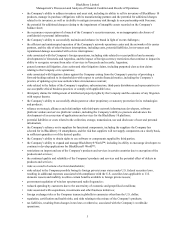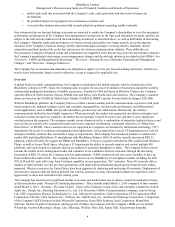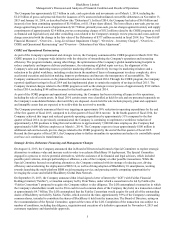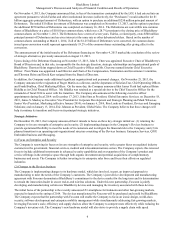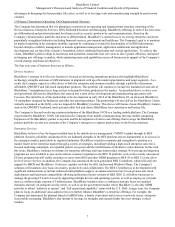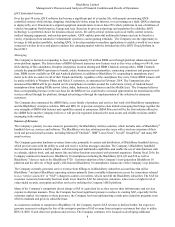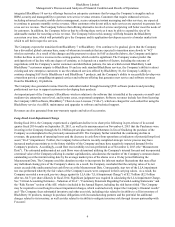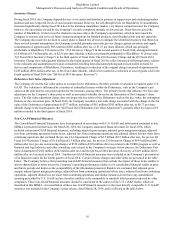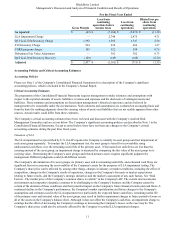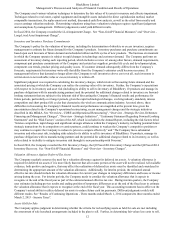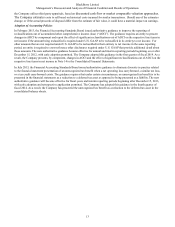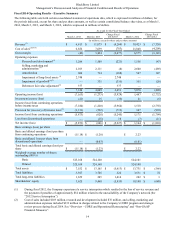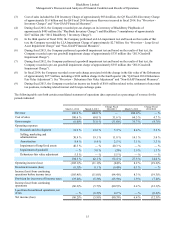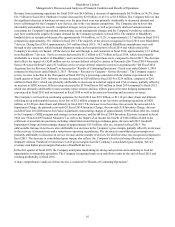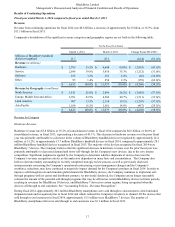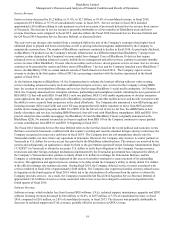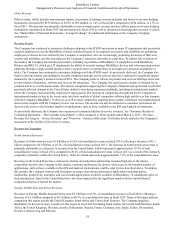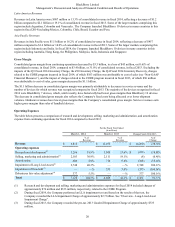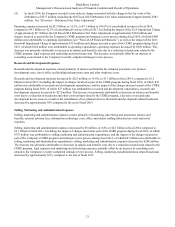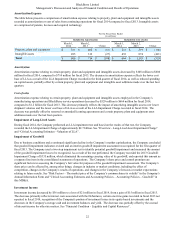Blackberry 2014 Annual Report Download - page 142
Download and view the complete annual report
Please find page 142 of the 2014 Blackberry annual report below. You can navigate through the pages in the report by either clicking on the pages listed below, or by using the keyword search tool below to find specific information within the annual report.BlackBerry Limited
Management’s Discussion and Analysis of Financial Condition and Results of Operations
12
The Company used various valuation techniques to determine the fair values of its assets to measure and allocate impairment.
Techniques related to real estate, capital equipment and intangible assets included the direct capitalization method, market
comparable transactions, the replacement cost method, discounted cash flow analysis, as well as the relief from royalty and
excess earnings valuation methods. Determining valuations using these valuation techniques requires significant judgement
and assumptions by management. Different judgements could yield different results.
In fiscal 2014, the Company recorded the LLA Impairment Charge. See “Non-GAAP Financial Measures” and “Overview -
Long-Lived Asset Impairment Charge”.
Inventory and Inventory Purchase Commitments
The Company’s policy for the valuation of inventory, including the determination of obsolete or excess inventory, requires
management to estimate the future demand for the Company’s products. Inventory purchases and purchase commitments are
based upon such forecasts of future demand and scheduled rollout and life cycles of new products. The business environment
in which the Company operates is subject to rapid changes in technology and customer demand. The Company performs an
assessment of inventory during each reporting period, which includes a review of, among other factors, demand requirements,
component part purchase commitments of the Company and certain key suppliers, product life cycle and development plans,
component cost trends, product pricing and quality issues. If customer demand subsequently differs from the Company’s
forecasts, requirements for inventory write-offs that differ from the Company’s estimates could become necessary. If
management believes that demand no longer allows the Company to sell inventories above cost or at all, such inventory is
written down to net realizable value or excess inventory is written off.
Significant judgment was required in calculating the inventory charges, which involved forecasting future demand and the
associated pricing at which the Company can realize the carrying value of its inventory. Further, the Company’s expectations
with respect to its inventory and asset risk (including its ability to sell its inventory of BlackBerry 10 products and manage its
purchase obligations with its manufacturing partners) and the potential for additional charges related to inventory are forward-
looking statements that are subject to the inherent risk of forecasting the Company’s financial results and performance for
future periods, particularly over longer periods, given the rapid technological changes, evolving industry standards, intense
competition and short product life cycles that characterize the wireless communications industry. As noted above, these
difficulties in forecasting the Company's financial results and performance are magnified at the present time given the
uncertainties related to the Company's operational restructuring, recent management changes and the strategic initiatives
described in this MD&A. See “Overview - CORE and Operational Restructuring”, “Overview - Strategic Review, Debenture
Financing and Management Changes”, “Overview - Strategic Initiatives”, “Cautionary Statement Regarding Forward-Looking
Statements” and the “Risk Factors” section of the AIF, which is included in the Annual Report, including the risk factors titled
“Intense competition, rapid change and significant strategic alliances within the Company’s industry, including potential future
strategic transactions by its competitors or carrier partners, could continue to weaken the Company’s competitive position or
may continue to require the Company to reduce its prices to compete effectively” and “The Company faces substantial
inventory and other asset risk, including risks related to its ability to sell its inventory of BlackBerry 10 products, manage its
purchase obligations with its manufacturing partners and the potential for additional charges related to its inventory, as well as
risks related to its ability to mitigate inventory risk through its new partnership with Foxconn.”
In fiscal 2014, the Company recorded the Z10 Inventory Charge, the Q3 Fiscal 2014 Inventory Charge and the Q4 Fiscal 2014
Inventory Recovery. See “Non-GAAP Financial Measures” and “Overview - Inventory Charges”.
Valuation Allowance Against Deferred Tax Assets
The Company regularly assesses the need for a valuation allowance against its deferred tax assets. A valuation allowance is
required for deferred tax assets if it is more likely than not that all or some portion of the asset will not be realized. All available
evidence, both positive and negative, that may affect the realization of deferred tax assets must be identified and considered in
determining the appropriate amount of the valuation allowance. Additionally, for interim periods, the estimated annual
effective tax rate should include the valuation allowance for current year changes in temporary differences and losses or income
arising during the year. For interim periods, the Company needs to consider the valuation allowance that it expects to
recognize at the end of the fiscal year as part of the estimated annual effective tax rate. During interim quarters, the Company
uses estimates including pre-tax results and ending position of temporary differences as at the end of the fiscal year to estimate
the valuation allowance that it expects to recognize at the end of the fiscal year. This accounting treatment has no effect on the
Company’s actual ability to utilize deferred tax assets to reduce future cash tax payments. Different judgments could yield
different results. See “Results of Continuing Operations - Three months ended March 1, 2014 compared to three months ended
March 2, 2013 - Income Taxes”.
Assets Held for Sale
The Company applies judgment in determining whether the criteria for reclassifying assets as held for sale are met including
the assessment of sale leaseback arrangements included in the plan to sell. Further, in determining fair values less costs to sell,


